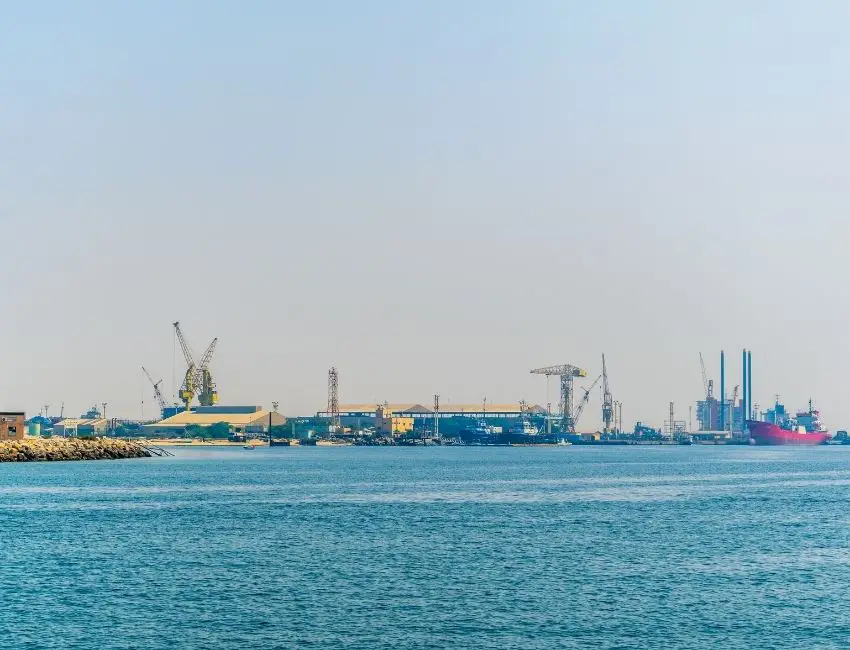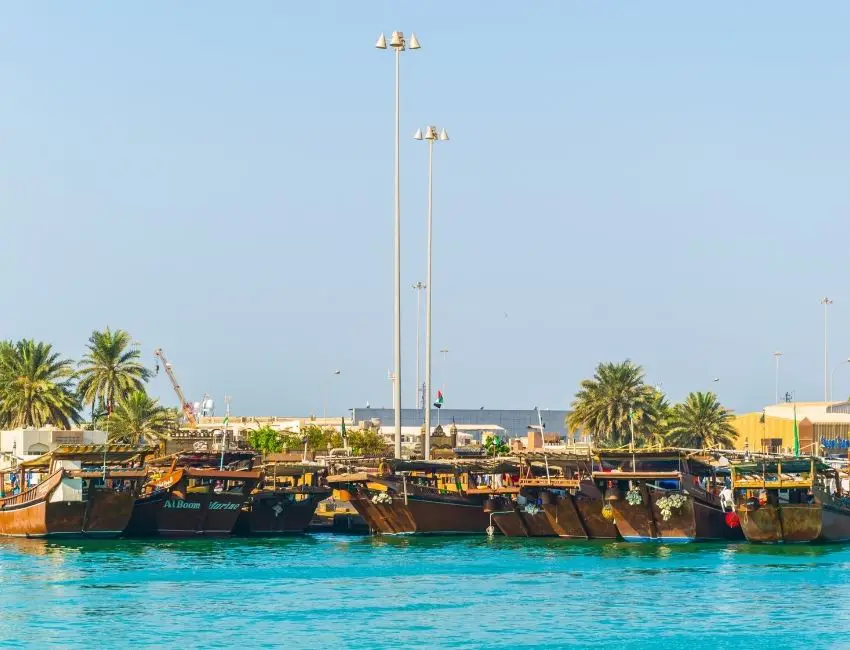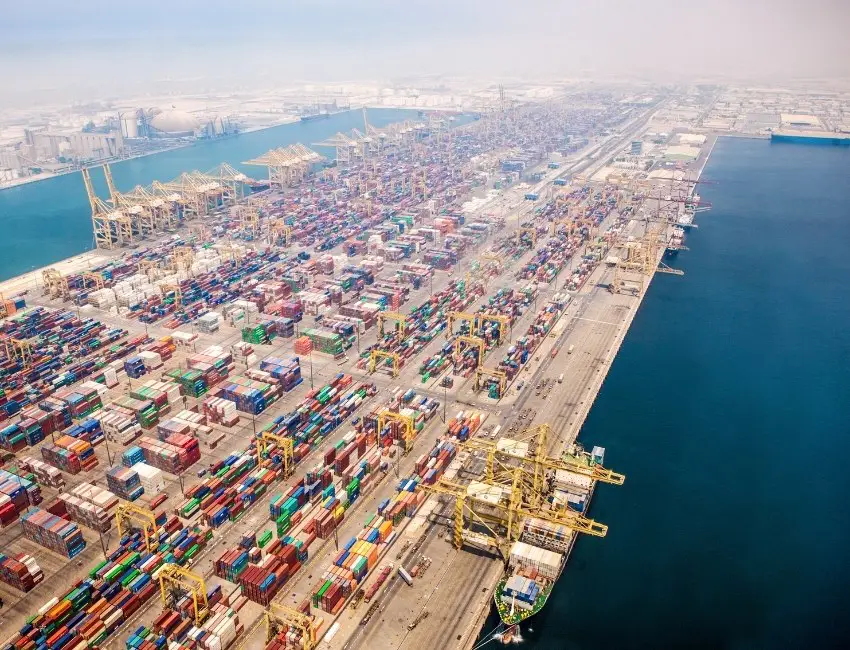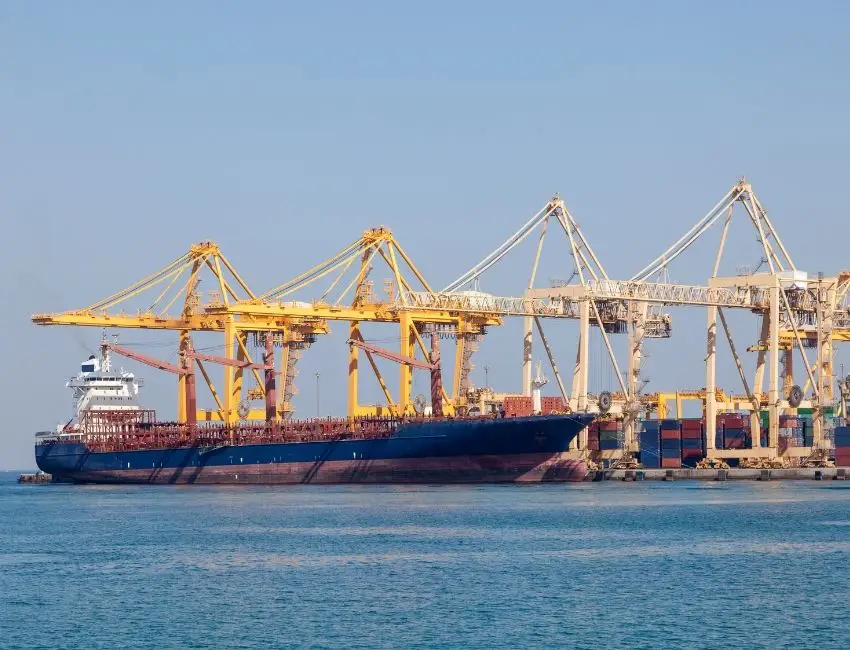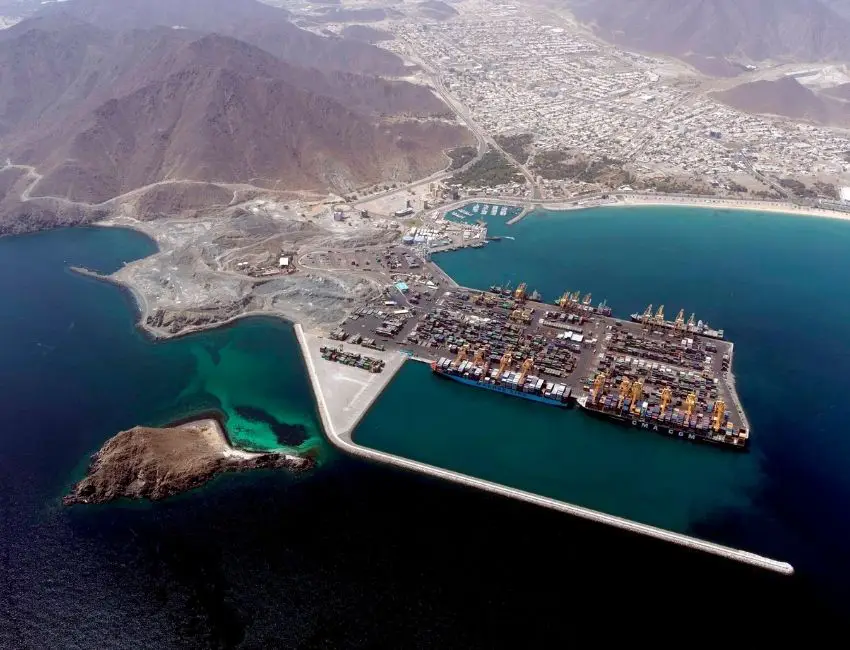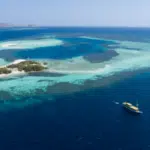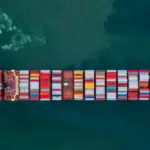10 Major Ports in Dubai and the United Arab Emirates
The United Arab Emirates (UAE) is a nation in the Middle East that is located near the Strait of Hormuz. It shares land borders with Oman and Saudi Arabia, and is well connected to other Gulf nations such as Qatar and Bahrain. It faces the Persian Gulf to the West, which is a major maritime trade route.
The UAE is formed from 7 Emirates- Abu Dhabi, Ajman, Dubai, Fujairah, Ras Al Khaimah, Sharjah, and Umm Al Quwain. Abu Dhabi is the capital while Dubai is the most populous Emirate.
The UAE is part of several inter-governmental corporations such as the UN, Gulf Cooperation Council (GCC), Arab League, and OPEC. The nation has large reserves of petroleum and natural gas. The petroleum reserves are ranked 6th in the world, while the natural gas reserves are ranked 7th.
The main sources of income are oil and tourism. The ports in the UAE are connected to other transport methods via road and air. The 2 national carriers- Emirates and Etihad Airlines, operate dedicated cargo and freight shipments from these ports to all over the world. Tourism, Oil, and the industrial sector are the main sources of revenue to the UAE.
Given its vast maritime importance, ports in Dubai and the UAE have played a major role in the development and growth of the country. In this article, we will look at the top 10 ports of the UAE. The Locode and Emirate are also mentioned.
These ports are the major shipping hubs spread throughout the various emirates. Note, the Locode begins with the prefix AE- indicating a port located within the territorial waters of the UAE.
The ports in this list are grouped in terms of the Emirate it belongs to. In Arabic, the term “Mina” means port or harbour. Most ports are also referred to by using Mina – before its name. So, for example, Port Khalifa (in Abu Dhabi) is also known as Mina Khalifa.
1. Port Khalifa (AEKHL)
Abu Dhabi
As the flagship port in Abu Dhabi, Port Khalifa is one of the largest deepwater harbours in the world. Located near the Taweelah offshore port, it is currently under construction and aims to be completed by 2030. It is part of the Khalifa Industrial Zone Abu Dhabi (KIZAD) that serves the Emirates of Dubai and Abu Dhabi and stretches out to sea on a reclaimed island. The Industrial Zone covers over 400 square kilometres and generates significant cargo and container traffic.
Port Khalifa is aimed at replacing cargo operations from Mina Zayed and has already begun handling container vessels diverted from Port Zayed. The proposed construction has been divided into 5 phases.
Phase 1 was launched in 2012 following the inauguration of the port in September. Phase 2 was launched in 2013. These phases will be completed by 2020 and 2021 respectively and will double the current container handling capacity.
The port services container vessels through a 30-year contract with Abu Dhabi Terminals (ADT) that currently processes 1.5 million TEUs annually. The present capacities are 2.5 million TEUs and 8 million tons of cargo.
Post completion of all phases, the port will be able to handle 15 million TEUs and 30-35 million tons of cargo. Dredging activity has created a 16-meter-deep harbour. As it is an artificial island, port Khalifa is connected to the mainland by a causeway that is located off the Ras Ghanada Coral Reef.
The port will have a 7.4 km quay, 22 container berths, 63 general cargo berths, and 6 dry bulk berths. It is fully equipped with customs, immigration, inspections, and security services. The port has stressed on technology and automating the infrastructure.
The container terminal is semi-automated, inventory stacks are fully automated, and tracking services are integrated into cargo shipments. 25-plus shipping lines operate from this port to 70 international destinations.
The port has 42 automated stacking cranes, 20 straddle carriers, and 12 ship-to-shore cranes in operation. These 12 STS Super Post Panamax cranes were supplied by Shanghai Zhenhua Heavy Industries (ZPMC) and are the largest in the world as of 2016.
2. Mina Zayed (AEMZD)
Abu Dhabi
Port Zayed is an important deep-water seaport of Abu Dhabi that has been operational since 1972. It services a large portion of vessels plying on the Gulf Coast and lies on an area of 25 square kilometres. The old container terminals occupy nearly 10% of the total area and are built to store up to 15,000 TEUs.
Following the complete transfer of container handling to Port Khalifa, these terminals are now defunct. There are rows of storage warehouses that contain general cargo, breakbulk, and use temperature controls to keep transit goods at peak condition.
Mina Zayed also allows companies to store and distribute goods from directly within the port premises, reducing transit times. A chilled storage zone caters to over 15,000 tons of frozen imports and exports.
The port has 21 berths for ro-ro, project cargo, reefer units, general cargo, and petroleum products. The initial 17 berths were expanded to service a larger number of vessels and process more cargo tonnage.
The quay length extends over 3 kilometres and has a maximum anchorage depth of 15 meters. However, berths 10 to 13 are just 6 meters deep, and they are only used by low draft vessels that carry the minimal load.
Vessels inbound to Mina Zayed can refuel directly from the Abu Dhabi National Oil Company’s (ADNOC) fuel bunkers that offer reduced rates. The port also has an engineering division on the call for vessel repairs and servicing.
There is also a Dhow Harbor located close to Mina Zayed. Vessels such as rig supply crafts, tug vessels, pleasure dhows, personal crafts, and small motorized launches berth here. The harbour is serviced by ADNOC, has equipment for service and repairs, and also has a direct connection with Port Zayed.
The erstwhile container plans were scrapped following the opening of Port Khalifa in September 2012. The now-closed facilities include 800 meters of quay, several heavy-duty cranes, and the proposed Saadiyat Island expansion plan.
This satellite port facility was planned to double as a Free Trade Zone, from where a larger number of container ships could be handled. To recover these, Abu Dhabi Ports plans to convert Port Zayed into a luxury cruise hub. AIDA and Celebrity Cruises have already begun cruise services from this port, and efforts have been made to convert it into a passenger port.
Related Reading:
3. Musaffah Port (AEAMF)
Abu Dhabi
Based out of the Musaffah Industrial Zone, this port is the 2nd oldest port in Abu Dhabi after Mina Zayed. It is a deep-water harbour that runs along the 53-kilometre Musaffah Channel. This channel provides a navigable canal through which the port is directly linked to the Persian Gulf. Dredging operations are underway to increase the channel draft.
Musaffah is a predominantly industrial district, and the same goes for the port. Passenger facilities are minimal here. There are several industries and factories that line the port face. These include steel machining, shipyards, rig and offshore constructions, dredging, commercial construction, and shipping.
Musaffah Port has advanced facilities to handle the various cargo vessels inbound. It can handle general cargo, breakbulk, solid bulk, and ro-ro ships. There are also large commercial warehouses which can be leased for storage and distribution of goods by companies within the port.
The facility is well connected to the surrounding regions by road and rail. The Etihad Rail project that is aimed at national rail connectivity has placed port networks as one of its objectives.
Musaffah is one of the ports that received the first links, alongside Jebel Ali and Mina Khalifa. This will create connectivity to neighbouring Saudi Arabia and Oman, as well as to other ports for transhipment. It is also connected by road to the Abu Dhabi International Airport.
This port is also the headquarters of the Abu Dhabi Ports Maritime Training Centre that offers international certification to mariners. The course is globally accredited by Lloyd’s Register and the UK Maritime and Coastguard Agency (MCA).
4. Port Jebel Ali (AEJEA)
Dubai
Mina Jebel Ali is a major port in Dubai, with over 15 million TEUs shipped in 2019. Built-in 1970, it was built to handle container and cargo traffic from Mina Rashid, and quickly overtook surrounding ports in terms of shipments.
Currently, Jebel Ali is the 9th busiest port in the world, the busiest in the Middle East, and handles a significant portion of container traffic through the region. It has won numerous awards for its infrastructure and facilities.
Jebel Ali Free Port is a hub for companies, both global and domestic. It includes a freight station (CFS) dealing with LCL container units.
The port is also well connected to the city, the Dubai International Airport, and the Airport Air Cargo Village. Mina Jebel Ali is the flagship port in Dubai Ports World’s global presence. It deals with shipments to Asia, the Middle East, Northern Africa, and Europe. The cargo handling capacity currently stands at 22.4 million TEUs.
The port has nearly 5 kilometres of quays, servicing ships from over 150 origin ports. The container terminals are divided into the T1, T2, and T3 zones, with a planned T4 zone on the way. T1 is the busiest terminal with 15 berths, 51 cranes, and a 9 million TEU capacity. It was the original terminal that the port operated from.
T2 can hold 6.5 million TEUs with 32 cranes and 8 berths. It is reputed for cutting on carbon emissions by a staggering 30%. T3 has 5 berths and can hold 3.8 million TEUs. It is highly advanced, with semi-automatic cranes that can process Ultra Large Container Vessels (ULCVs) that store over 18,000 TEUs. The proposed terminal T4 will add 3.1 million TEUs to the existing facilities.
5. Mina Rashid (AEDXB)
Dubai
Port Rashid is an important passenger and cargo port in Dubai and was the first commercial port in the Emirate. It handled container and cargo operations until they were shifted to Jebel Ali.
The port was opened in 1972 as a small trading harbour, with a capacity of less than 0.1 million TEUs. Today, it boasts of a 1.5 million TEU capacity alongside state-of-the-art technology and new equipment. It is owned and managed by DP World.
This hub is gradually being converted into a fully passenger and cruise port in Dubai. Jebel Ali began handling cargo operations from 2008 and operations were completely shifted by 2018. Mina Rashid is currently under expansion and redevelopment.
It handles ro-ro, ro-pax, general passenger, and cruise vessels. There are also minor cargo operations at the port premises. Extensive real estate development is planned along the waterside to convert the port into a major tourism site. Cunard Lines and the Carnival Corporation currently have agreements to begin operations from this port by 2020 end.
The Dubai Drydocks are located near Mina Rashid and have been operational since 1983. It is the largest dry dock facility along the Persian Coast. The Dubai Maritime City is also near the port and is planned to open in 2021. It is divided into the Maritime Centre, Industrial Precinct, Academic Precinct, Marine District, Harbor Residence, and the Harbor Offices.
6. Mina Al Hamriyah (AEHAM)
Dubai
Located on mainland Dubai and shielded from the Persian Gulf by the Deira Islands, this port is an important trading and passenger harbour and lies close to the Port Rashid.
Al Hamriyah is not to be confused with the Mina Hamriyah Port located in the Free Port Zone of Sharjah. Although it is a small port, it handles a large portion of livestock, fish, frozen and fresh foods, and passenger traffic in the region.
It was built to reduce pressure on Dubai Creek. The Palm Deira is a luxury residential complex built facing the port, which is in the final stages of construction.
The Port is currently managed by Dubai Ports World and is under expansion to build an additional 2.5 kilometres of quay length. It handles trade with Asia, parts of Africa, and Europe.
The port is also close to the Al Hamriyah Civil Defense Station and the Department of Passport Control. It is well connected to the other Emirates by an extensive road and rail network. Moreover, Dubai International Airport is just a short distance from it.
7. Port of Fujairah (AEFJR)
Fujairah
As the largest port in the UAE on the Eastern Coast, the port of Fujairah is a major deep-water port in the region. It has a coastal breakwater and has an average anchorage depth of 16.5 meters. The port has been operational since 1983, while oil terminals were added in 2006 and 2010. The port is a multipurpose harbour that is close to the Straits of Hormuz.
The port is well connected to the surrounding Emirates and is part of the cross UAE expressway. It is connected to the Etihad Rail project that provides transport to Dubai, Sharjah, Ras Al Khaimah, Um Al Qwain, Abu Dhabi, and Al Ain. The main services provided by this port include cargo, container, and oil shipments. It is built to handle general cargo, project cargo, bulk cargo, wet bulk, fuel etc.
The port breakwaters are divided into the North and South zones. The North zone houses the 2 oil terminals. The South zone deals with repairs and general cargo handling. As the largest Eastern port, it has immense regional importance.
The Habshan-Fujairah Oil pipeline moves up to 3/4th of the UAE’s oil production and an average of 2 million barrels per day. The port also has a naval base of the UAE Navy that is stationed to provide anti-piracy protection to oil tankers in the region. The port stands out for being the world’s 2nd largest bunkering hub, with extensive facilities for fuel-supplying and management.
8. Port of Ras Al Khaimah (AERKT)
Ras Al Khaimah
As one of the Northernmost ports in the UAE, RAK Harbor is an important trading post in the region. Situated close to the Strait of Hormuz, vessels covering parts of Asia, Europe, and Africa are serviced here. The Ras Al Khaimah Port actually includes several smaller ports, such as Mina Saqr and Mina Al Jazeera harbours, in addition to the main RAK harbour.
As a modern port, RAK has several Free Port Zones that provide operational spaces to several international companies, and also provide storage to various shipping lines. There are provisions to handle general cargo, liquid and bulk cargo, and reefers. RAK Port has cruise and passenger terminals that cater to a large portion of the regional tourism.
The Mina Saqr port is located further North and deals with cargo and commercial shipments. The RAK Maritime Training Center is close to the port. It has a Free Port Zone that was known earlier as RAK Maritime City, with extensive storage space.
The main shipment through Saqr is construction materials. Al Jazeera Port is located South of the main RAK facility and deals with repairs and ship servicing. It operates dockyards that have advanced equipment and machinery. There are also Marinas nearby that berth pleasure crafts, yachts, and personal boats.
9. Port of Khor Al Fakkan (AEKLF)
Sharjah
Located on the Indian Ocean coast, the port of Khor Al Fakkan is an important cargo hub of the region. It lies close to the Straits of Hormuz and is within 3 hours from Dubai and Abu Dhabi.
It is on the Eastern coast of the Musandam Peninsula and lies on the Gulf of Oman. It is one of the largest transhipment harbours around the world and caters to ships crossing through the East-West route via the Indian Ocean. It is primarily a container and cargo handling port that services surrounding regions of Sharjah.
The port has 6 quays, spanning a total over 2 kilometres that have an average anchorage depth of 16 meters. The port facility sits over 700,000 square meters and has on-site storage covering 450,000 square meters. The container terminal of Khor Fakkan, known as KCT, has storage capacities for 45,000 TEUs. It also has a consolidation and deconsolidation yard within the premises, for handling LCL units. There are facilities to handle up to 1,000 reefers at a given time.
To service the vessels that come in, the port has 20 large container cranes. These are machinery that can service Super post-Panamax vessels. There is a total of 26 gantry cranes, 30 container handlers, and 116 terminal tractors.
Construction of a further 4 Megamax Tandem Lift cranes is also underway. There is an expansion effort being undertaken by the government of Sharjah to overcome the geographical isolation of this port.
10. Port Khalid (AEKHL)
Sharjah
As one of the main ports of Sharjah, Mina Khalid is built to handle cargo including general, dry, liquid, bulk, and containers. The port is operated under the Department of Seaports and Customs, along with Hamriyah and Khor Fakkan.
The port has extensive storage facilities for all types of goods. This includes cold stores, reefer storage zones, bulk cargo holding areas etc. An adjacent oil terminal also boosts the productivity of the harbour.
It currently operates 33 multi-purpose berths including 21 general cargo berths. The rest handle miscellaneous cargo. The container terminals are berths 1 – 3 and are operated by the Gulftainer Company, alongside the container terminal at Khor Al Fakkan. Berths 4 – 8 deals with general and ro-ro cargo. Berths 9 – 13 perform repairs, and process bulk oil. Berths 14 – 16 handle reefer and timber cargo. Berth 16 and 17 deal in grain storage through on-site silos. Berth 18 deals with oil shipments, while berths 19 – 21 handle oil tankers.
Mina Khalid also has an Inland Container Depot (known as ICD) that is connected to other parts of Sharjah. It is also connected by road to other Emirates in the UAE. The port services both the Sharjah Airport Free Zone and Al Hamriyah Free Zone, and is situated on an important trade route to the Indian Ocean. The port also provides services to over 1.2 billion individuals and has a very high turn around time for incoming vessels. It has advanced facilities and auxiliary services such as piloting, tugs, and stevedores attached to the port.
You might also like:
- 10 Major Ports In The Dominican Republic
- 11 Major Container Terminal Operators In The World
- Top 10 Busiest Ports In The World
- Major Container Ports And Port Operators in the World In 2020
Disclaimer: The authors’ views expressed in this article do not necessarily reflect the views of Marine Insight. Data and charts, if used, in the article have been sourced from available information and have not been authenticated by any statutory authority. The author and Marine Insight do not claim it to be accurate nor accept any responsibility for the same. The views constitute only the opinions and do not constitute any guidelines or recommendations on any course of action to be followed by the reader.
The article or images cannot be reproduced, copied, shared, or used in any form without the permission of the author and Marine Insight.
Do you have info to share with us ? Suggest a correction

About Author
Ajay Menon is a graduate of the Indian Institute of Technology, Kharagpur, with an integrated major in Ocean Engineering and Naval Architecture. Besides writing, he balances chess and works out tunes on his keyboard during his free time.
Latest Maritime Knowledge Articles You Would Like:
Subscribe To Our Newsletters
By subscribing, you agree to our Privacy Policy and may receive occasional deal communications; you can unsubscribe anytime.



